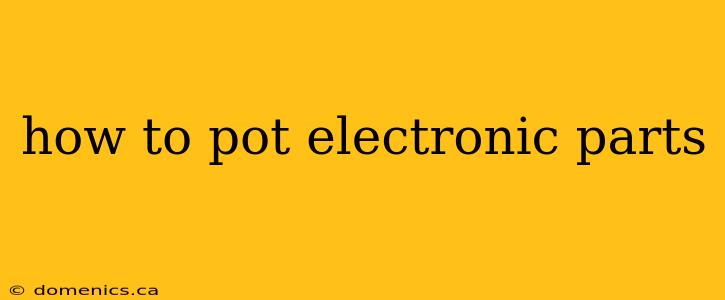Electronic potting is a crucial process for protecting sensitive components from harsh environments. It involves encapsulating electronic parts in a protective resin, safeguarding them from moisture, vibration, shock, and temperature fluctuations. This guide will walk you through the steps of successfully potting your electronic parts.
Why Pot Electronic Components?
Potting offers several key advantages:
- Environmental Protection: Shields components from moisture, dust, chemicals, and other environmental contaminants. This is vital for outdoor applications or in environments with high humidity.
- Mechanical Protection: Absorbs shocks and vibrations, crucial for components in moving machinery or devices subjected to physical stress.
- Improved Thermal Management: Some potting compounds offer thermal conductivity, helping to dissipate heat generated by electronic components. This prevents overheating and extends component lifespan.
- Improved Electrical Insulation: Provides enhanced electrical insulation, preventing short circuits and improving safety. This is critical in high-voltage applications.
Choosing the Right Potting Compound
Selecting the appropriate potting compound is paramount. Consider these factors:
- Viscosity: The thickness of the compound influences how easily it can be poured and fill intricate spaces.
- Curing Time: The time it takes for the compound to harden completely. Fast-curing compounds are convenient, but slower-curing options often provide better results.
- Thermal Conductivity: If heat dissipation is a concern, choose a compound with high thermal conductivity.
- Dielectric Strength: Important for electrical insulation; higher dielectric strength ensures better protection against short circuits.
- Compatibility: Ensure the compound is compatible with your electronic components and won't cause corrosion or damage.
Preparing for Potting
Before you begin, ensure you have the necessary materials and follow these steps:
- Gather Supplies: You will need the potting compound, mixing cups and sticks (if required), gloves, safety glasses, a mold or container, and any necessary tools for placing components into the mold.
- Prepare the Mold: Select a mold that's slightly larger than your electronic assembly. Ensure it's clean and dry. You may need to use mold release agent for easy removal later.
- Prepare the Components: Clean your electronic components thoroughly to remove any dust or debris. Ensure all connections are secure before potting. Use wire ties or other methods to keep components in place. Consider using potting sleeves for added protection of individual components or wires.
The Potting Process: A Step-by-Step Guide
- Mixing the Compound: If your potting compound requires mixing (two-part epoxy, for example), carefully follow the manufacturer's instructions. Thorough mixing is crucial for proper curing and performance.
- Pouring the Compound: Gently pour the mixed compound into the mold, ensuring it completely surrounds the electronic components. Avoid trapping air bubbles; carefully pour slowly to minimize air pockets. A vacuum degassing chamber can greatly reduce air bubbles.
- Removing Air Bubbles: Gently tap the mold to help release any trapped air bubbles. A vacuum chamber or pressure pot can be more effective in eliminating air bubbles.
- Curing the Compound: Allow the compound to cure according to the manufacturer's specifications. This may take several hours or even days. Avoid disturbing the mold during the curing process.
- Removing from Mold: Once cured, carefully remove the potted assembly from the mold.
Post-Potting Considerations
- Inspection: Inspect the potted assembly for any imperfections, such as voids or cracks.
- Testing: Conduct thorough testing to ensure the potting process hasn't damaged the electronic components.
- Cleanup: Clean your tools and work area thoroughly after completing the potting process.
Troubleshooting Common Potting Issues
- Air Bubbles: Thorough mixing and degassing techniques are key to minimize bubbles.
- Incomplete Curing: Ensure proper mixing and adhere to the curing time specified by the manufacturer.
- Component Damage: Always carefully handle components and inspect before potting.
Conclusion
Potting electronic parts is a valuable technique for protecting sensitive electronics in demanding environments. By following these steps and selecting the appropriate potting compound, you can ensure the longevity and reliability of your electronic devices. Remember safety first and always consult the manufacturer's instructions for your specific potting compound.
